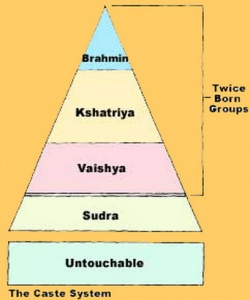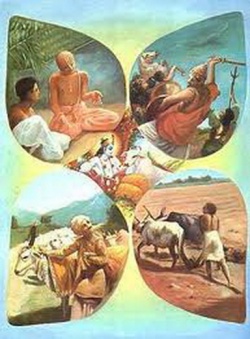Varna
Varna refers to the categorization of the Hindu society by four castes, hypothesized by the Brahmins and their Sacred Texts. This quadruple division is not to be confused with Jāti or even the much finer division of the contemporary Caste system in India. The four varnas, or chatur varna, are mentioned in ancient texts in the following (stratified) order, from top to bottom,
the Brahmins: vedic priests.
the Kshatriya: kings, governors and soldiers.
the Vaishyas: cattle herders, agriculturists, artisans]and merchants.
the Shudras: labourers and service providers.
The first three varna are considered Arya, and thus allowed to participate in Vedica Rituals from which the non-Arya Shudra varna is excluded.
Separate and shunned by society, including the Shudras, were the "untouchables" such as the Dalit and the Chandaal (cāṇḍāla), who had to deal with the disposal of dead bodies and are described as dirty and polluted. There was a belief that one's Karma in the past, resulted in one's condition in this birth. "Now people here whose conduct is good can expect to quickly attain a pleasant birth, like that of a Brahmin, the Kshatriya, or the Vaishya. But people of Evil conduct can expect to enter a foul womb, like that of a dog, a pig, or a Chandaal".
Caste politics is a controversial issue in the contemporary Republic of India and the varna concept forms a part of those politics.
Etymology and origins
Varna is a Sanskrit term varṇa (वर्ण) is derived from the root vṛ, meaning "to cover, to envelop" (compare vṛtra). Derived meanings include "kind, sort, character, quality". All these meanings are already present in the Rigveda's use of the word.
The earliest application to the formal division into four social classes appears in the late Rigvedic Purusha Sukta (RV 10.90.11–12), which has the Brahman, Rajanya (= Kshatriya), Vaishya and Shudra classes emerging from the mouth, arms, thighs and feet of the primordial giant, Purusha, respectively. Other Vedic texts and the Manusmriti, a law text dating to roughly between 200 BCE and 200 CE follow suit.
The varna system of the Brahminical society is described in the various Puranas and Smritis, among others. Manusmriti, is one of numerous Dharmashastra texts reflecting the laws and society of Maurya period India and being a reference work for the Brahmins of Bengal especially, was relied upon by the British colonial administrators and scholars based in Calcutta, the capital city. Manusmriti was almost unknown south of the Vindhyas. The modern Hindu Caste system recognizes many more social groupings not mentioned in the Hindu scriptures and only theoretically accepts the necessity of following prescribed duties.
Rigvedic evidence of such a quadruple division of society has been compared to similar systems, especially with a view to reconstructing hypothetical Proto-Indo-European society. Such comparison is at the basis of the trifunctional hypothesis presented by Georges Dumézil. Dumézil postulates a basic division of society into a priesthood (Brahmins), warrior class or nobility (Kshatriyas) and commoners (Vaishyas), augmented by a class of unfree serfs (Shudras), as was done in ancient Iran and Greece as well (where the fourth class is called pan-Hellenes).

